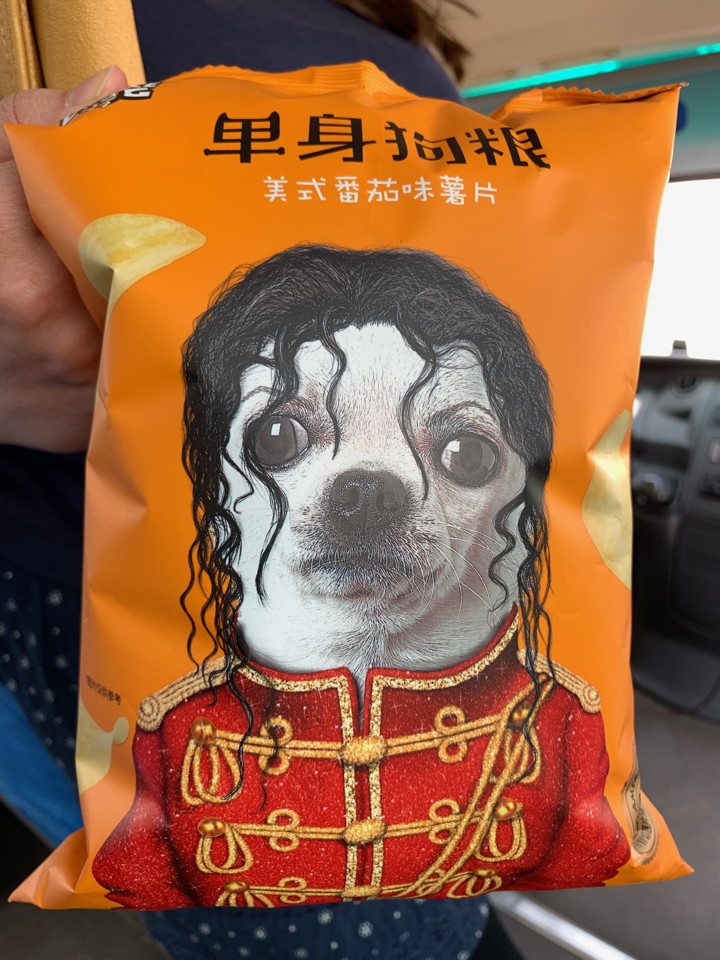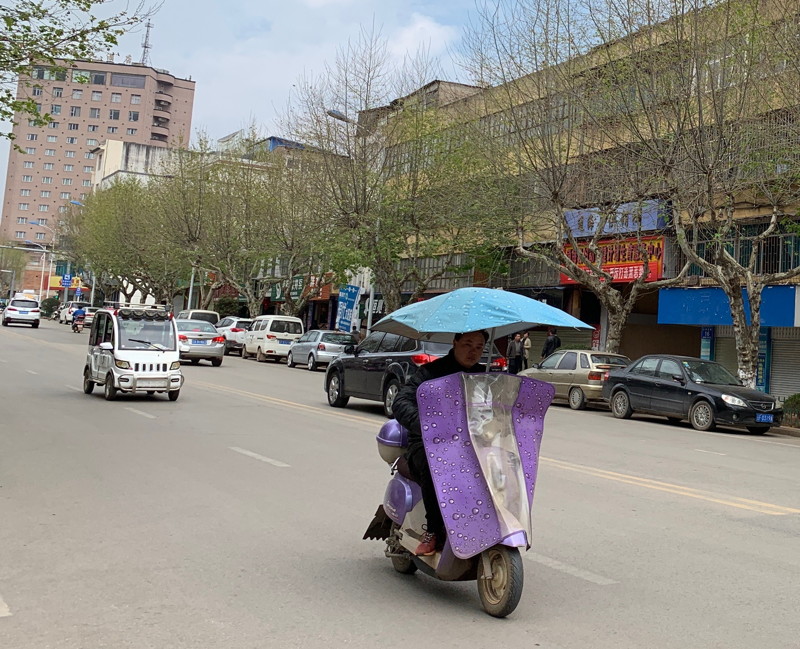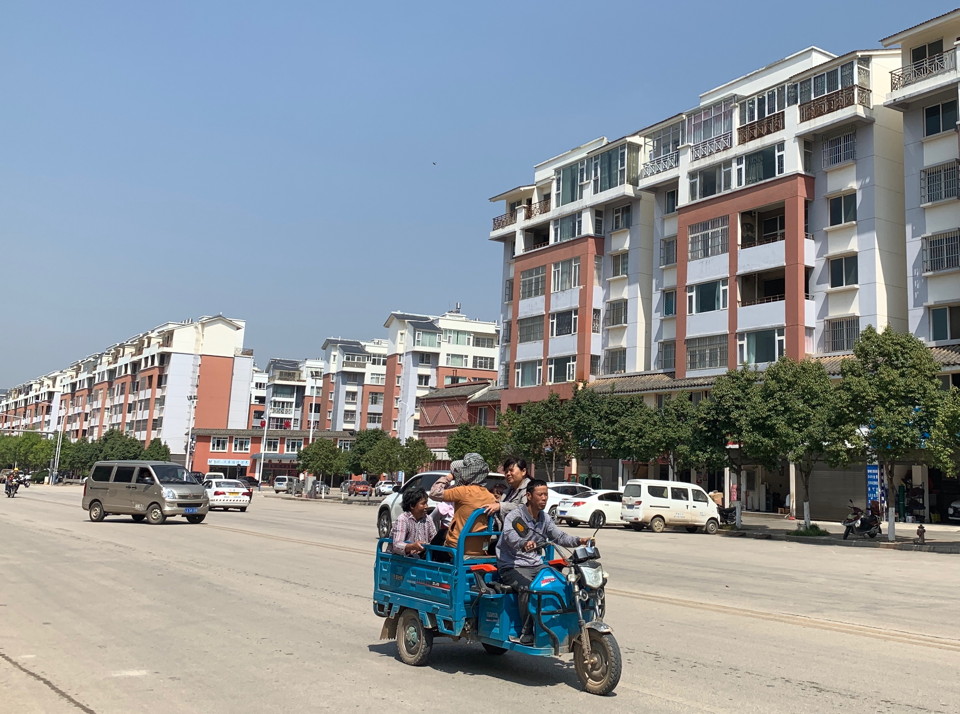Driving

Driving through the misty hills
The drive from Kunming to Yuanyang was the longest of our trip but by this time we'd grown used to long road journeys through the Yunnan countryside. We stopped along the way at service stations, small town eateries, or the occasional viewpoint but generally we just pressed on, eating up the miles to our next destination. I've found that photos taken while driving rarely turn out well so these hours became an opportunity to observe & reflect on what we were passing through and to try and get an overall impression of the land.
We drove through valleys flanked by mountains. Most of the time the peaks were covered in forest and would be veiled in mists as they grew more distant, becoming overlapping shapes in shades of green and blue/grey. The valley floors were a mosaic of tilled fields stretching to the foothills on either side, these fields never grew very big and each seemed a different crop to its neighbours, the varying shades of green forming a patchwork effect. It gave the impression of a huge but very well maintained group of allotment plots nestling together. Irrigation channels were usually dead straight and a crisscross grid of paths tied it all together. It looked like a land that had been extensively farmed for a very long time, adjusted & refined until it perfectly matched the terrain.
The towns & villages slotted very precisely into this landscape. Rather than slowly transition into the farmland with larger, detached houses and bigger gardens there was usually a sharp divide - one side of the road would be apartment blocks, the other open fields. In fact there didn't seem to be any private gardens at all, even the smallest towns would consist of multi-storey blocks placed cheek by jowl in a sea of agriculture.
The roads were generally very good (although there were some very bumpy sections, often as we approached a city) and clearly signposted in both Chinese and English. Service stations were frequent and very well maintained with clean toilets, large shops selling snacks & travel essentials (some had restaurants too but we never ate in one), and often nicely laid out rest areas in addition to fuel & garage services.
The police presence was very low in the areas we visited but it did show up a bit more on the roads. Several times we'd come across police checkpoints where some (occasionally all) vehicles were flagged down, from our own stops this seemed to be primarily to check papers. A futuristic note was struck when I saw one of the officers with a forearm-mounted tablet computer typing in our driver's details, presumably to have them remotely verified. A lot of the signs above the roadways appeared to have speed cameras fitted (you could tell by the flashes) but these seemed to take pictures of every vehicle that passed underneath, regardless of type or speed. A more low-tech device was the animated mannequin policeman or road worker, slowly waving their arms to warn of an obstruction ahead.
Tunnels and long flyover bridges were very common as we drove along and the level of infrastructure construction was startlingly high throughout the area. We'd often see a progression of bridges & tunnels being built for a new road or railway that would extend for miles as we paralleled its route, presumably to augment or supercede the roadway we were currently on. These were often being built over the foothills of the valley sides rather than along the flatter floor and several of the existing routes were raised up on flyovers instead of being at ground level - this could have been for flood avoidance or to maintain a gradient but it gave the impression of wanting to preserve the maximum amount of farmland despite the extra cost.
New construction was also very visible at the rim of cities where we'd often see groups of apartment blocks being raised together. These would often be enormous - eight or more blocks of over thirty stories was not unusual - and really brought home the size & population levels of the places we were driving through. Even bearing in mind that there were twenty Chinese for every Brit I was often taken aback to find that somewhere we were visiting that I'd never heard of before had a greater population than London.
When we did stop for a meal break we'd usually come off the big road and go to somewhere that the driver (who was from Yunnan) recommended - this was, after all, the local knowledge that we were paying for. These small town (for China) places would often appear deserted at first but would manage to whip up a splendid meal for ten people in five or ten minutes and charge what seemed like a trifling amount for it, often a bottle of the local beer would cost more than the food. And it was consistently delicious, subtly or dramatically different from other meals we'd had. Although we'd not seen the huge range of culinary variation that the brochure had promised - the dishes we were served often had the same general make up - the little changes between eateries kept things interesting, for me at least.
These small town stops also provided a glimpse into 'ordinary' life (although statistically I suspect the city dwellers were more typical). Towns were modern with long blocks of apartments, wide streets, and a fascinating mixture of old & new vehicles. Although most cars were petrol driven (as were the agricultural trucks with their fully exposed engines) almost all of the smaller vehicles were electric, including the tiny car models we'd seen in Dali. Lots of the mountain ridges had wind turbines along them and this emphasis on clean transport seemed well coordinated.

Service station snack selection

Building crew at a service station

Words fail me - service station crisps







